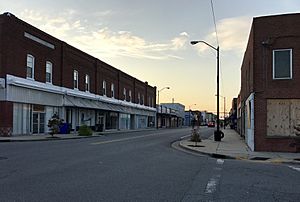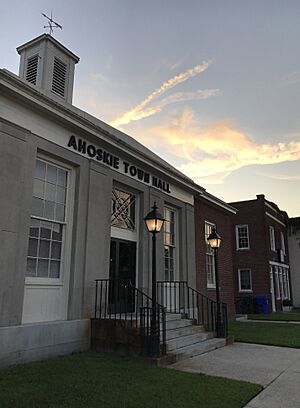Ahoskie, North Carolina facts for kids
Quick facts for kids
Ahoskie, North Carolina
|
||
|---|---|---|

View down Main Street in Ahoskie, facing west
|
||
|
||
| Motto(s):
"The Only One"
|
||

Location of Ahoskie, North Carolina
|
||
| Country | United States | |
| State | North Carolina | |
| County | Hertford | |
| Area | ||
| • Total | 4.40 sq mi (11.40 km2) | |
| • Land | 4.40 sq mi (11.40 km2) | |
| • Water | 0.00 sq mi (0.00 km2) | |
| Elevation | 52 ft (16 m) | |
| Population
(2020)
|
||
| • Total | 4,891 | |
| • Density | 1,111.34/sq mi (429.09/km2) | |
| Time zone | UTC-5 (Eastern (EST)) | |
| • Summer (DST) | UTC-4 (EDT) | |
| ZIP code |
27910
|
|
| Area code(s) | 252 | |
| FIPS code | 37-00500 | |
| GNIS feature ID | 2405124 | |
Ahoskie (pronounced ah-HOSS-kee) is a town in Hertford County, North Carolina, United States. In 2020, about 4,891 people lived there. Ahoskie is located in a part of North Carolina called the Inner Banks.
It's known as "The Only One" because no other town in the world has the same name! The name "Ahoskie" was first spelled "Ahotsky." It came from the Wyanoke Indians, who lived in the Hertford County area when Europeans first settled there.
Contents
History of Ahoskie
Ahoskie started as a small stop for trains carrying logs in 1885. These trains moved timber from nearby forests to a sawmill. The town grew around a loading station and supply stores for the workers.
Ahoskie got its own post office in 1889. The first passenger train came through town in 1890 on new tracks.
Town Growth and Early Businesses
By the time Ahoskie officially became a town on January 24, 1893, it had several stores. It also had a sawmill, a machine for separating cotton fibers, a one-room school, and a Baptist church.
Other early businesses included an ice plant and a laundry. There were also places to buy and sell horses and mules. Since many smaller towns didn't have passenger train lines, traveling salespeople often used Ahoskie as a base. They would travel to nearby stores by horse and buggy.
The town's first bank, the Bank of Ahoskie, opened in 1905. The economy in this area first focused on growing tobacco and cotton. It has mostly stayed a rural area with small towns.
Ahoskie has several important historical places. These include the Ahoskie Historic District and the Ahoskie Downtown Historic District. There are also individual buildings like the Ahoskie School and the Roberts H. Jernigan House. These places help people learn about the town's past.
African American Community History
After the American Civil War, the first school for Black students in Ahoskie was built. This one-room schoolhouse opened around 1868. Van Butler was the first teacher, and the school term lasted four months.
Over many years, the Black community worked hard to improve education. By 1939, the Ahoskie Graded School had two brick buildings. It had 14 elementary teachers and five high school teachers. About 800 students attended the school.
The first Black church, the New Ahoskie Baptist Church, started in 1866. Other early churches in the Black community were the Methodist Church and Calvary Baptist Church.
The first charity group in the Black community was Love and Charity. This group helped its members and met in their homes. Other early groups included the Elks and Masons.
By 1939, the town had many Black-owned businesses. These included grocery stores, barber shops, cafes, and a dry goods store. There were also hairdressers, seamstresses, a doctor, and two funeral homes.
Special Events and Modern Times
Perhaps the biggest show ever seen in Ahoskie was Buffalo Bill's Wild West Show in October 1916. About 12,000 people came to see it! The town's leaders hosted a breakfast for Col. William F. Cody.
Electric lights were first turned on in Ahoskie around Christmas in 1915. At first, the power came from a gasoline engine. Within two years, electricity was available day and night.
Ahoskie was the first stop in North Carolina for First Lady Claudia Alta Johnson. She visited on October 6, 1964, during her train tour of the South.
Geography of Ahoskie
Ahoskie covers about 4.35 square miles of land. It does not have any large bodies of water within its town limits.
Ahoskie Population Facts
| Historical population | |||
|---|---|---|---|
| Census | Pop. | %± | |
| 1900 | 302 | — | |
| 1910 | 924 | 206.0% | |
| 1920 | 1,429 | 54.7% | |
| 1930 | 1,940 | 35.8% | |
| 1940 | 2,313 | 19.2% | |
| 1950 | 3,579 | 54.7% | |
| 1960 | 4,583 | 28.1% | |
| 1970 | 5,105 | 11.4% | |
| 1980 | 4,887 | −4.3% | |
| 1990 | 4,391 | −10.1% | |
| 2000 | 4,523 | 3.0% | |
| 2010 | 5,039 | 11.4% | |
| 2020 | 4,891 | −2.9% | |
| 2022 (est.) | 4,657 | −7.6% | |
| U.S. Decennial Census | |||
Population in 2020
| Group | Number | Percentage |
|---|---|---|
| White (not Hispanic) | 1,158 | 23.68% |
| Black or African American (not Hispanic) | 3,334 | 68.17% |
| Native American | 57 | 1.17% |
| Asian | 68 | 1.39% |
| Pacific Islander | 1 | 0.02% |
| Other/Mixed | 165 | 3.37% |
| Hispanic or Latino | 108 | 2.21% |
In 2020, there were 4,891 people living in Ahoskie. There were 1,895 households and 1,044 families.
Population in 2010
In 2010, Ahoskie had 5,039 people. The town had about 1,169 people per square mile. Most of the people were African American (66.6%) or White (28.5%).
The average age in Ahoskie was about 39.5 years old. About 28.1% of the people were under 20 years old. About 19.7% were 65 years or older.
Businesses and Colleges in Ahoskie
Ahoskie is home to the Roanoke-Chowan News-Herald newspaper. A steel factory called Nucor Steel is located nearby in Cofield.
Roanoke-Chowan Community College is just outside Ahoskie. In the late 1990s, the town gave an old elementary school to Shaw University. This university opened a center there to help people improve their job skills and education.
Notable People from Ahoskie
Many interesting people have come from Ahoskie, including:
- Kentwan Balmer – a football player in the NFL
- Bobby Futrell – a football player for the Tampa Bay Buccaneers
- Sam Harrell – a football player for the Minnesota Vikings
- Robert Lee Holloman – a member of the North Carolina General Assembly
- Jason Horton – a former football player in the NFL and CFL
- Howard J. Hunter Jr. – a member of the North Carolina General Assembly
- Toran James – a former football player in the NFL
- Ella Mitchell – a soul singer and actress
- Dick Newsome – a baseball pitcher for the Boston Red Sox
- Timmy Newsome – a football player for the Dallas Cowboys
- Amber O'Neal – a professional wrestler
- Graham Smith – a Tuskegee Airman (a famous group of African American military pilots)
- Robert Lee Vann – a newspaper publisher and editor
- Tom Umphlett – a baseball player for the Boston Red Sox
- Oshane Ximines – a football player for the New York Giants
See also
 In Spanish: Ahoskie (Carolina del Norte) para niños
In Spanish: Ahoskie (Carolina del Norte) para niños



